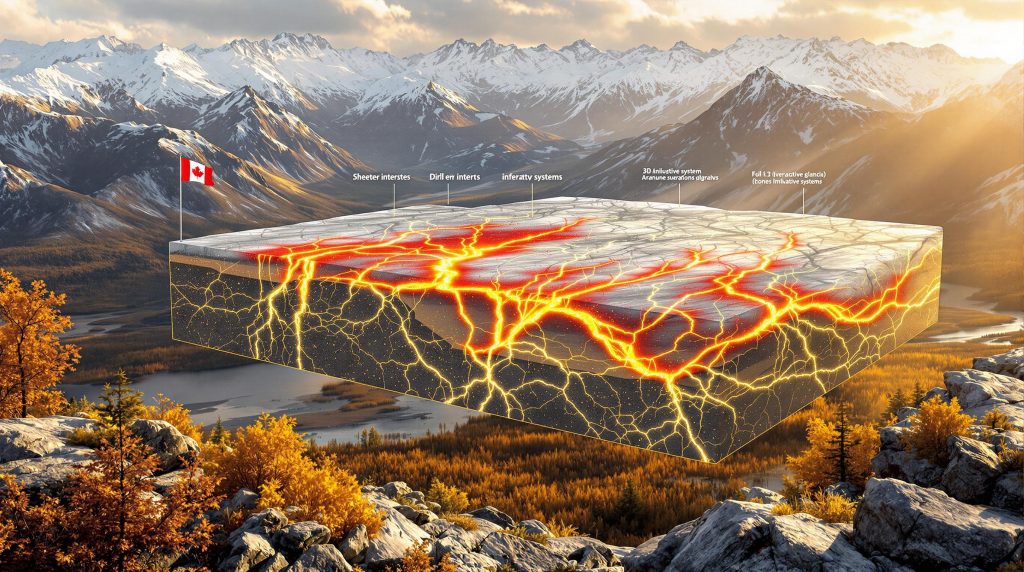What Makes the Yukon a Gold Hotspot?
The Yukon Territory has emerged as one of North America's most promising gold frontiers, with its rich geological history creating ideal conditions for significant deposits. This Canadian territory's unique geological formations have produced over 12.6 million ounces of gold since records began, making it a key region for exploration companies and investors alike.
The territory's vast expanse of 482,443 square kilometers contains numerous gold-bearing systems that continue to attract substantial investment. What makes the Yukon particularly interesting is the diversity of its deposits, including placer, orogenic, and intrusion-related systems that offer various opportunities for a new gold discovery in Yukon and development.
The Geological Advantage of Yukon Gold
The Yukon's geological makeup features multiple gold-bearing belts characterized by complex metamorphic and igneous rocks. These formations were created through millions of years of tectonic activity, where magma chambers pushed upward through the Earth's crust, creating networks of mineralized veins.
These intrusive systems often contain substantial gold mineralization in the form of sheeted quartz veins. The region's unique geological history includes deep-seated structures that allowed gold-bearing magmas to rise through the crust, creating conditions favorable for large, consistent deposits that exploration companies prize.
Key geological features include:
- Deep structural corridors that served as conduits for mineralizing fluids
- Multiple phases of intrusive activity creating overlapping mineralized zones
- Favorable host rocks that efficiently trapped gold mineralization
- Preservation conditions that protected deposits from erosion over millions of years
Why This Renaissance in Yukon Gold Exploration Matters
Recent years have witnessed a significant revival in precious metals interest, with gold increasingly viewed as an important store of value during economic uncertainty. This renewed focus has channeled much-needed capital into mining exploration, particularly in historically productive regions like the Yukon.
The Yukon Bureau of Statistics reported mineral exploration expenditures totaling CAD $84.6 million in 2022 alone, demonstrating substantial financial commitment to the region. This influx of capital has enabled companies to deploy advanced technologies and exploration techniques that weren't available during previous exploration cycles.
What makes this exploration renaissance particularly significant is its timing within the broader economic cycle. Many industry experts believe we're witnessing the early stages of a prolonged precious metals bull market, suggesting significant growth potential ahead for companies with substantial Yukon gold assets.
Important note for investors: While exploration results from the Yukon are promising, the timeline from discovery to production typically spans 5-10 years, requiring patience and careful due diligence before investment.
Recent Major Gold Discoveries in the Yukon
The Yukon has seen several significant gold discoveries in recent years that have reignited interest in the territory's mineral potential. These discoveries range from extensions of known deposits to entirely new systems, showcasing the region's untapped potential.
Modern exploration techniques have allowed companies to look deeper and more systematically than previous generations of explorers. This methodical approach has revealed substantial new gold zones that might have remained hidden using older exploration methods.
Valley Zone: A Substantial Discovery
The Valley Zone represents one of the significant gold finds in recent Yukon history, with considerable resources identified through extensive drilling programs. What makes this deposit particularly remarkable is its consistency and predictability—characteristics that mining companies highly value when assessing development potential.
Key Features of Major Yukon Discoveries:
- Consistent gold distribution throughout large volumes of rock
- Predictable mineralization patterns that follow geological models
- Substantial size potential with multiple zones of mineralization
- Location within known gold-bearing geological trends
The Importance of Extension Discoveries
Recent drilling near established gold zones has revealed promising extensions that could significantly expand resource footprints. These extension discoveries are particularly valuable as they can potentially leverage existing infrastructure and geological understanding.
When companies identify extensions to known deposits, they often represent lower-risk exploration targets compared to entirely new areas. The geological similarities to established mineralization provide greater confidence in the potential economic viability of these extensions.
What Drill Core Reveals About New Discoveries
Core samples from recent Yukon drilling programs display characteristic features that experienced geologists can interpret to understand gold distribution. These features include:
- Sheeted quartz veining patterns that indicate systematic mineral deposition
- Sulfide minerals such as arsenopyrite that often associate with gold
- Alteration halos surrounding veins that suggest hydrothermal activity
- Structural controls like fractures and faults that channeled mineralizing fluids
The presence of these features helps exploration geologists target their drilling programs more effectively, increasing the odds of significant discoveries while minimizing costly exploration in barren areas. Understanding drill results interpretation is crucial for evaluating potential new gold discovery in Yukon.
How Are Explorers Finding New Yukon Gold?
Advanced Exploration Techniques
Companies exploring the Yukon are employing sophisticated techniques that go far beyond the simple prospecting methods of the past. Modern exploration in the territory relies on a multi-disciplinary approach combining geology, geochemistry, geophysics, and data analysis.
The Yukon Geological Survey maintains an online mineral exploration database and mapping system (YGS GeoPortal) that provides valuable baseline data for exploration companies. This publicly available information helps companies target their initial exploration efforts more effectively.
Modern exploration techniques in the Yukon include:
-
Advanced Geophysical Surveys: Airborne magnetic and electromagnetic surveys that can detect subtle variations in rock properties associated with gold mineralization
-
Systematic Soil Sampling: Collection and analysis of thousands of soil samples to identify geochemical anomalies that might indicate underlying gold deposits
-
Structural Mapping: Detailed analysis of rock structures to understand the controls on gold mineralization and predict its distribution
-
Machine Learning Applications: Using artificial intelligence to identify patterns in exploration data that might be missed by human analysts
-
3D Modeling: Creating comprehensive three-dimensional models of geology and mineralization to guide drilling programs
Multiple Target Approach
Successful explorers in the Yukon recognize that gold deposits rarely occur in isolation. Instead, they typically form in clusters or districts where geological conditions were favorable for multiple mineralization events.
This understanding has led exploration companies to pursue multiple targets simultaneously, rather than focusing all resources on a single prospect. This diversified approach increases the odds of success while providing valuable data about regional geological controls on mineralization.
The multiple target approach typically involves:
- Ranking exploration targets based on geological potential and accessibility
- Testing several distinct target types to understand which host the best mineralization
- Using discoveries at one target to refine the exploration model for others
- Building a pipeline of prospects at different stages of advancement
This methodology has proven particularly effective in the Yukon, where the vast territory contains numerous underexplored areas with significant discovery potential. The mineral exploration importance cannot be overstated for finding new deposits in this resource-rich region.
Beyond Valley: Other Promising Yukon Gold Targets
The Yukon hosts numerous exploration targets beyond the well-known discoveries, each with distinct geological characteristics that make them promising for future development. These targets represent the next generation of potential Yukon gold deposits.
Different Target Types Across the Territory
Across the Yukon, exploration companies are investigating various styles of gold mineralization, each with its own geological signature and economic potential.
Intrusion-Related Gold Systems:
- Characterized by gold associated with granitic intrusions
- Often feature predictable sheeted vein networks
- Can form large tonnage, moderate-grade deposits
- Typically show a distinct suite of associated metals (bismuth, tungsten, etc.)
Orogenic Gold Systems:
- Form along major structural corridors
- Often produce high-grade but geometrically complex deposits
- Feature quartz veins with visible gold and sulfides
- Can extend to significant depths
Epithermal Gold Systems:
- Form at relatively shallow depths in volcanic terrains
- Often feature distinctive banded quartz veins
- Can produce spectacular gold grades in bonanza zones
- May transition to porphyry systems at depth
Geological Indicators of Promising Targets
Geologists look for specific features when evaluating the potential of Yukon gold targets:
-
Intrusive Contacts: The boundaries between intrusive rocks and surrounding country rock often provide favorable sites for gold deposition
-
Structural Intersections: Where major faults or shear zones cross each other, creating zones of enhanced permeability for mineralizing fluids
-
Alteration Patterns: Changes in rock chemistry and mineralogy caused by hydrothermal fluids that often precede or accompany gold deposition
-
Geochemical Anomalies: Elevated levels of pathfinder elements (arsenic, antimony, bismuth) in soils or rocks that can indicate nearby gold mineralization
By systematically evaluating these indicators, exploration companies can prioritize targets and allocate drilling resources more effectively.
The "Hidden Gold" Phenomenon in Yukon Exploration
Bismuth Association: Gold Without Visibility
One of the most intriguing aspects of Yukon gold exploration is the "hidden gold" phenomenon. In many Yukon deposits, gold particles are microscopically small or chemically bound within other minerals, making them invisible to the naked eye despite potentially economic concentrations.
This characteristic creates both challenges and opportunities for explorers:
Challenges:
- Traditional visual identification methods may miss significant mineralization
- Core logging requires greater reliance on laboratory assays
- Exploration models must account for invisible gold distribution
Opportunities:
- Deposits overlooked by earlier explorers focused on visible gold
- Potential for discoveries in areas previously considered barren
- Application of modern analytical techniques to detect invisible gold
The association between gold and bismuth minerals is particularly important in many Yukon deposits. Gold atoms can substitute for bismuth within crystal structures or form microinclusions within bismuth minerals, creating a situation where high gold values may be present with no visible gold particles.
Vein Density Mapping as a Proxy
Given the challenges of visually identifying gold in many Yukon deposits, explorers have developed alternative methods to guide their exploration efforts. One powerful technique involves mapping the density of quartz veins as a proxy for potential mineralization.
This approach recognizes that in many intrusion-related gold systems, the density of sheeted quartz veins correlates strongly with gold grade. Areas with more veins per meter of rock typically contain higher gold concentrations, even when no visible gold is present.
Vein density mapping involves:
- Counting the number of quartz veins per meter in drill core or outcrop
- Creating detailed logs of vein characteristics (thickness, mineralogy, orientation)
- Developing 3D models showing zones of intense veining
- Correlating vein density with assay results to refine the exploration model
This technique allows geologists to make real-time decisions about drilling targets without waiting for assay results, significantly improving exploration efficiency.
Investment Implications of Yukon Gold Discoveries
Early Stage of a New Gold Cycle
The current exploration boom in the Yukon appears to be positioned in the early stages of a longer-term precious metals cycle. Historical analysis suggests that gold exploration and development typically move through multi-year cycles of investment, discovery, development, and production.
Several factors suggest we may be in the early stages of such a cycle:
- Increasing capital flows into precious metals exploration after years of underinvestment
- Multiple new discoveries emerging simultaneously across the territory
- Growing interest from both specialized mining investors and generalist funds
- Consolidation beginning among companies with significant discoveries
For investors, the early stage of an exploration cycle often presents both the highest risk and the highest potential reward. Companies making significant discoveries can see substantial share price appreciation, while those with unsuccessful exploration programs may struggle to raise additional capital. Understanding current gold market trends is essential when evaluating these opportunities.
Development Timeline Considerations
While exploration results from the Yukon are promising, investors should understand the typical timeline for mine development in the territory:
Exploration Phase (1-5 years):
- Initial discovery and definition drilling
- Preliminary resource estimates
- Early-stage economic assessments
Development Phase (3-7 years):
- Environmental baseline studies and permitting
- Feasibility studies and engineering
- Financing arrangements
- Construction of mine and processing facilities
Production Phase (10+ years):
- Commercial production and ongoing optimization
- Potential expansion of operations
- Exploration for additional resources
This extended timeline means that even the most promising discoveries today may not produce revenue for 5-10 years. Investors must carefully consider their investment horizon and risk tolerance when evaluating Yukon gold exploration companies.
Cluster Potential and Strategic Value
The geological setting of Yukon gold deposits suggests potential for multiple discoveries within relatively small geographic areas. This clustering effect creates strategic value beyond the economics of individual deposits.
When multiple deposits occur in proximity, they can potentially share:
- Processing facilities and infrastructure
- Power generation and distribution
- Transportation networks
- Technical expertise and workforce
This clustering effect has attracted the attention of major mining companies looking to establish district-scale operations. For junior exploration companies with significant discoveries, this strategic value can make them attractive acquisition targets for larger players seeking to establish a foothold in the region. As highlighted in recent gold mining stocks analysis, companies with Yukon assets are increasingly drawing investor attention.
What's Next for Yukon Gold Exploration?
Pending Assay Results and News Flow
The Yukon exploration season typically runs from May through October, with drilling programs generating samples that are sent to laboratories for analysis. This creates a predictable cycle of news flow, with preliminary drilling results announced during the field season and comprehensive results following in the winter months.
Investors and industry observers should watch for:
- Initial drill results from new target areas
- Step-out drilling results that could expand known deposits
- Updated resource estimates incorporating new drilling data
- Technical reports analyzing the economic potential of discoveries
These announcements can significantly impact company valuations and investor sentiment toward the broader Yukon gold sector.
Winter Planning and Analysis
As the Yukon exploration season winds down, companies shift their focus to data analysis and planning for the following year. This winter period is critical for:
- Analyzing drilling results and refining geological models
- Updating mineral resource estimates
- Planning next season's exploration programs
- Raising capital for future exploration
For investors, this winter period often provides an opportunity to evaluate companies based on their results and future plans before the next exploration season begins.
Potential for Major Resource Expansion
The combination of new discoveries and extensions to known deposits suggests significant potential for resource growth across the Yukon. This expansion potential comes from several sources:
- Lateral Extensions: Drilling beyond the boundaries of known mineralization
- Depth Extensions: Testing the continuation of mineralization at greater depths
- Satellite Deposits: Discovering additional mineralized zones near known deposits
- New Target Concepts: Applying successful exploration models to untested areas
The cumulative effect of these expansion opportunities could substantially increase the territory's gold resource base over the coming years, potentially establishing the Yukon as a globally significant gold production region. With the current gold price forecast, companies making new discoveries in the Yukon may be well-positioned to capitalize on favorable market conditions.
FAQ About Yukon Gold Discoveries
How do Yukon gold deposits compare to other global gold regions?
Yukon's gold deposits typically feature large tonnage with moderate grades that can be amenable to bulk mining methods. While average grades may be lower than some high-grade underground mines globally, the consistent nature of mineralization and potential for large-scale operations make them economically attractive.
Unlike the narrow, high-grade veins found in some regions, Yukon deposits often present as broader zones of mineralization that can be mined more efficiently using open-pit methods. This operational advantage can offset the somewhat lower average grades.
What challenges do Yukon gold explorers face?
Exploration in the Yukon faces several significant challenges:
- Seasonal Limitations: The harsh winter climate restricts field operations to approximately 5-6 months annually
- Remote Locations: Many promising areas lack road access and basic infrastructure
- Permitting Requirements: Comprehensive environmental studies and consultations with First Nations are required
- Water Management: Designing operations that protect water resources in a sensitive environment
- Infrastructure Costs: Building roads, power generation, and other facilities in remote locations
Despite these challenges, the Yukon benefits from a stable political environment, established mining regulations, and generally supportive local communities. The territory's government has worked to streamline permitting processes while maintaining environmental standards.
How might these discoveries impact gold supply?
While still in exploration stages, successful development of multiple Yukon gold deposits could provide a significant new source of gold production in North America. This could help offset declining production from aging mines globally and support supply in a period of increasing demand.
The timing of potential Yukon production is particularly relevant given:
- Declining grades at many existing global gold mines
- Depletion of easily accessible reserves in traditional mining regions
- Increasing political risks in some major gold-producing countries
- Growing demand for gold from both industrial applications and investment
However, the long development timeline means that Yukon discoveries are unlikely to impact global gold supply for at least 5-10 years, and their ultimate contribution will depend on how many exploration projects successfully transition to production.
What geological features make the Yukon special for gold?
The Yukon's unique geological history includes several features that create favorable conditions for gold mineralization:
-
Ancient Continental Margin: The region formed along the edge of the North American continent, where geological processes concentrated minerals
Want to Catch the Next Major Gold Discovery?
Stay ahead of the market with Discovery Alert's proprietary Discovery IQ model, which instantly notifies investors of significant ASX mineral discoveries and turns complex data into actionable insights. Explore why major mineral discoveries can lead to substantial returns by visiting Discovery Alert's dedicated discoveries page and begin your 30-day free trial today.




